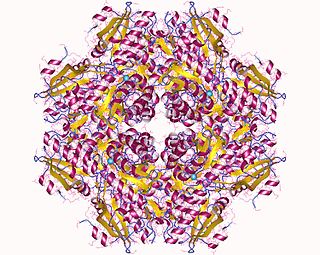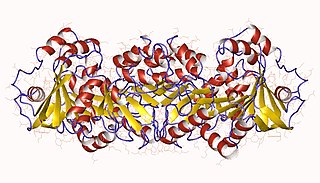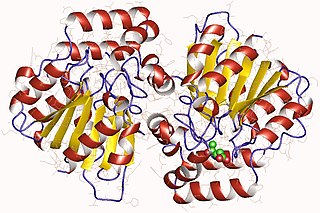Catechol dioxygenases are metalloprotein enzymes that carry out the oxidative cleavage of catechols. This class of enzymes incorporate dioxygen into the substrate. Catechol dioxygenases belong to the class of oxidoreductases and have several different substrate specificities, including catechol 1,2-dioxygenase, catechol 2,3-dioxygenase, and protocatechuate 3,4-dioxygenase. The active site of catechol dioxygenases most frequently contains iron, but manganese-containing forms are also known.

Muconate lactonizing enzymes are involved in the breakdown of lignin-derived aromatics, catechol and protocatechuate, to citric acid cycle intermediates as a part of the β-ketoadipate pathway in soil microbes. Some bacterial species are also capable of dehalogenating chloroaromatic compounds by the action of chloromuconate lactonizing enzymes. MLEs consist of several strands which have variable reaction favorable parts therefore the configuration of the strands affect its ability to accept protons. The bacterial MLEs belong to the enolase superfamily, several structures from which are known. MLEs have an identifying structure made up of two proteins and two Magnesium ions as well as various classes depending on whether it is bacterial or eukaryotic. The reaction mechanism that MLEs undergo are the reverse of beta-elimination in which the enolate alpha-carbon is protonated. MLEs can undergo mutations caused by a deletion of catB structural genes which can cause some bacteria to lose its functions such as the ability to grow. Additional mutations to MLEs can cause its structure and function to alter and could cause the conformation to change therefore making it an inactive enzyme that is unable to bind its substrate. There is another enzyme called Mandelate Racemase that is very similar to MLEs in the structural way as well as them both being a part of the enolase superfamily. They both have the same end product even though they undergo different chemical reactions in order to reach the end product.

Catechol 1,2- dioxygenase is an enzyme that catalyzes the oxidative ring cleavage of catechol to form cis,cis-muconic acid:

In enzymology, a homoisocitrate dehydrogenase (EC 1.1.1.87) is an enzyme that catalyzes the chemical reaction
In enzymology, a carboxy-cis,cis-muconate cyclase is an enzyme that catalyzes the chemical reaction

In enzymology, a chloromuconate cycloisomerase is an enzyme that catalyzes the chemical reaction
In enzymology, a dichloromuconate cycloisomerase is an enzyme that catalyzes the chemical reaction
In enzymology, a muconolactone Δ-isomerase is an enzyme that catalyzes the chemical reaction
The enzyme 3-chloro-D-alanine dehydrochlorinase (EC 4.5.1.2) catalyzes the reaction
The enzyme 4-carboxymuconolactone decarboxylase (EC 4.1.1.44) catalyzes the chemical reaction
The enzyme 5-oxopent-3-ene-1,2,5-tricarboxylate decarboxylase (EC 4.1.1.68) catalyzes the chemical reaction

In enzymology, an aspartate 4-decarboxylase (EC 4.1.1.12) is an enzyme that catalyzes the chemical reaction
The enzyme protocatechuate decarboxylase (EC 4.1.1.63) catalyzes the chemical reaction
The enzyme 4-oxalmesaconate hydratase (EC 4.2.1.83) catalyzes the chemical reaction

The enzyme homoaconitate hydratase (EC 4.2.1.36) catalyzes the chemical reaction

The enzyme 3-oxoadipate enol-lactonase (EC 3.1.1.24) catalyzes the reaction

In enzymology, a homocitrate synthase (EC 2.3.3.14) is an enzyme that catalyzes the chemical reaction

3-Carboxy-cis,cis-muconic acid is a metabolite of the catechin degradation by Bradyrhizobium japonicum.
Fumarate lyase belongs to the lyase class of enzymes. These proteins use fumarate as a substrate. They have been shown to share a short conserved sequence around a methionine which is probably involved in the catalytic activity of this type of enzymes.
4-oxalomesaconate tautomerase is an enzyme with systematic name 4-oxalomesaconate keto---enol-isomerase. This enzyme catalyses the following chemical reaction









